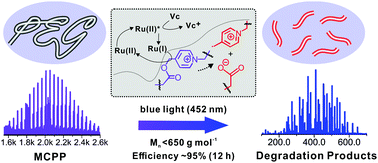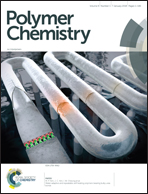Designing a main-chain visible-light-labile picolinium-caged polymer and its biological applications†
Abstract
Designing a main-chain visible-light-labile polymer is still a challenging task in related fields. In this work, a picolinium-caged main-chain photolabile polymer (MCPP) is firstly reported, where the C–O bonds of picolinium groups are efficiently cleaved (>95%) upon visible light irradiation (452 nm). The degradation rate of the MCPP is easily tuned by adjusting the concentration of the catalyst, irradiation intensity and time. Importantly, after photodegradation, the molecular weight of degradation products is decreased to less than 650 g mol−1. It is found that, unlike forming a helix structure of pure polyethylene glycol in water, the picolinium-caged MCPP is in a linear conformation. Moreover, nanopore-based single-molecule analysis indicates that both the MCPP and degradation products can easily pass through a biomimetic lipid membrane, and the passing speed can be tuned by varying the applied bias voltage. Cell cytotoxicity and proliferation experiments demonstrate that both the MCPP and degradation products are nontoxic, but only the MCPP is favorable for cell proliferation. On the basis of these results, it is anticipated that the MCPP is an exceptional candidate of photodegradable materials in chemistry, pharmacy, materials science and medicine.



 Please wait while we load your content...
Please wait while we load your content...